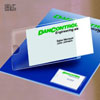Shopping Cart [more]
Index of Products
Information
- 9PTK Titration Instructional Videos
- Automatic Rinse Tank Controls
- Boiler and Cooling Towers
- Circuit Board Cleanliness Testing
- Deionized Water
- Environmental Applications
- Fountain Solutions
- Frequently Asked Questions
- Glossary of Terms
- Hemodialysis Applications
- Horticulture
- Hydroponics
- Material Safety Data Sheets
- Operation Manuals / Instructions
- Oxidation Reduction Potential (ORP)/Redox
- Pool and Spa
- Product Data Sheets
- Reverse Osmosis
- Technical Reference: Handheld pH Instruments
- Textile Manufacturing
Fountain Solutions
WHY TEST FOUNTAIN SOLUTIONS?
Accurate fountain (dampening) solution concentration control is essential for consistent, high-quality results in lithography. Low concentration can cause drying on the non-image area of the plate resulting in tinting, scumming, blanket piling, etc. High concentrations, on the other hand, bring about over-emulsification of the ink. This results in weakening of color strength and changes in ink rheology (body and flow properties). Correct concentration will allow the non-image areas of the plate to be appropriately wetted.
WAYS TO TEST
Traditionally, pH was the test relied on to determine fountain solution concentration. Today, however, conductivity testing is recognized as a much more accurate method. Many modern dampening solutions are pH stabilized (or buffered), so only small changes in pH are seen even when dramatic changes occur in solution strength. Conductivity measurement is a fast and easy test which is more indicative of fountain solution concentration than pH. This is true for all neutral, alkaline, and many acid type solutions.
pH is still important, however, with unbuffered acid fountain solutions. Checking both conductivity and pH can provide valuable information. Acid fountain solution is a mixture of gum arabic, wetting agents, salts, acids, buffers, etc. Conductivity will tell you if the proper amount of most ingredients are present, but pH is necessary to check acid concentrations. pH will also determine how effective one ingredient, gum arabic, will be.
CONDUCTIVITY TESTING
What is conductivity? Conductivity is the measurement of a solution's ability to conduct an electrical current. It is usually expressed in microsiemens (micromhos). Absolutely pure water is actually a poor electrical conductor. It is the substances dissolved in water which determine how conductive the solution will be. Therefore, conductivity is an excellent indicator of solution strength. To properly measure the conductivity of fountain solutions:
- Test and write down the conductivity of the water used to prepare the solution.
- Mix the fountain solution concentrate with the water, using the manufacturer's recommendations or as experience dictates.
- Measure the conductivity of the mixed solution.
- Subtract the water conductivity value obtained in step 1. This is necessary because tap water quality can change from day to day.
The resulting number is an accurate indicator of fountain solution strength. Caution: because alcohol will lower a solution's conductivity, always test solution conductivity before and after the addition of alcohol.
Determining the best concentration of fountain solution is mostly "trial and error." It can be very useful to make a graph, recording readings for every one-half or one ounce of concentrate added to a gallon of water. Record readings on a graph with the vertical axis representing conductivity values and the horizontal axis representing ounces/gallon. Such a graph will help "fine tune" your system during future press runs.
For "on the spot" fountain solution tests, Myron L® handheld instruments are fast, accurate, and reliable. Measurements are made in seconds simply by pouring a small sample of solution into the instrument cell cup and pressing a button. Automatic temperature compensated accuracy and famous MYRON L® reliability have made our instruments popular in pressrooms worldwide.
pH TESTING
Even though pH usually is not the best method to check the concentration of fountain solution, it is still very important and must be checked regularly. The pH of acid dampening solution affects sensitivity, plate-life, ink-drying, etc. Also, pH can change during a run if the paper has a high acid or alkaline content. pH, therefore, must be maintained at the proper level for good printing.
A convenient and accurate way to test pH (as well as temperature) is Myron L®'s waterproof ULTRAMETER II™ Model 6PFCE or TECHPRO II™ TH1. The 6PFCE has a 100 reading memory and the TH1 has a 20 reading memory to store test results onsite. The 6PFCE also measures conductivity. All electrodes are contained in the cell cup for protection. Model M6/PH also measures pH and conductivity.
CONTINUOUS CONTROL
For continuous monitoring and/or control of fountain solution concentration, MYRON L® offers a complete series of in-line conductivity instruments. These economical, accurate, and reliable models use a remotely installed sensor and a panel/wall mount meter enclosure. Most contain an adjustable set point and heavy duty relay circuit which can be used to activate alarms, valves, feed pumps, etc. All models contain a 0-10VDC output for a chart recorder or PLC (SCADA) input, if required, (4-20mA output is also available).
The 750 Series II with dual set point option has become quite popular in pressrooms. The two set points allow a "safe zone" for controlling fountain solution concentration.
LITHO-KIT™
Ultrameter II 6PFCE, 512M5 and M6/PH are available with the useful LITHO-KIT™. This accessory includes a foam-lined, rugged all-plastic carrying case with calibrating solutions and buffers. In addition, a syringe to simplify drawing samples and a thermometer for testing fountain solution temperature are also included.
| PROBLEM | REMEDY | RECOMMENDED MYRON L® MODELS |
| Improperly mixed fountain solution | Carefully follow manufacturer’s directions, checking both water and mixed solution with a conductivity instrument | Ultrameter 4PII, 6PIIFCE and 9PTK; ULTRAPEN PT1; and TechPro II TPH1 or TP1 all test 0-9999 ppm TDS or microsiemens conductivity, and temperature. 512M5 portable DS Meter™ with a 0-5000 microsiemens conductivity range. |
| Halftones sharpen and highlight dots lost during run | Check pH of fountain solution to determine if it's too acidic | Ultrameter 4PII, 6PIIFCE and 9PTK; ULTRAPEN PT2; and TechPro II TH1. M6/PH portable pDS Meter. Ranges: 0-5000 microsiemens and 2-12 pH. |
| Reverse osmosis water treatment system monitor indicates membrane failure | Test RO water quality and verify in-line instrument accuracy | Ultrameter 4PII, 6PIIFCE and 9PTK; ULTRAPEN PT1; and TechPro II TPH1 or TP1 all test 0-9999 ppm TDS or microsiemens conductivity, and temperature. |
| Scum streaks across plate after 10,000-20,000 impressions | Check acid/gum levels in fountain solution | Ultrameter 6PIIFCE and 9PTK; ULTRAPEN PT2; and TechPro II TH1. M6/PH portable pDS Meter. Ranges: 0-5000 microsiemens and 2-12 pH. |
| Personnel unable to test fountain solution concentration | Continuously control fountain solution with conductivity monitor/controller | 758II-123 (0-5000 µS) in-line monitor/controller |
Other products and companies referred to herein are trademarks or registered trademarks of their respective companies.
**Prices, images and specifications subject to change without notice.**


For your convenience, we accept these credit cards:











